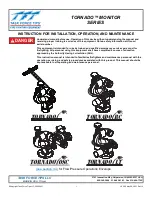
Subject to change without notice
25
Triggering Checks
The internal trigger threshold is important as it determines
the display height from which a signal will be stably
displayed. It should be approx. 0.3-0.5div. for the HM303.
An increased trigger sensitivity creates the risk of response
to the noise level in the trigger circuit. This can produce
double-triggering with two out-of-phase traces.
Alteration of the trigger threshold is only possible internally.
Checks can be made with any
sine-wave voltage
between
50Hz and 1MHz. The
AT/NORM.
button should be in out
position (
Automatic Triggering
). Following this it should
be ascertained whether the same trigger sensitivity is also
present with Normal Triggering (
AT/NORM.
button
depressed). In this trigger mode, a
LEVEL
adjustment is
necessary. The checks should show the same trigger
threshold with the same frequency. On depressing the
SLOPE
button, the start of the sweep changes from the
positive-going to the negative-going edge of the trigger
signal.
As described in the Operating Instructions, the trigger
frequency range is dependent on the trigger coupling
selected. For lower frequencies the
LF
coupling mode can
be selected. In this mode, triggering up to at least 1.5kHz
(sine-wave) is possible. Internally the HM303 should
trigger perfectly at a display height of approx. 0.5div.,
when the appropriate trigger coupling mode is set.
For external triggering (
TRIG. EXT.
button depressed),
the
EXT. TRIG.
input connector requires a signal voltage
of at least
0.3V
pp
, which is in synchronism with the Y input
signal. The voltage value is dependent on the frequency
and the trigger coupling mode (
AC-DC-LF
).
Checking of the TV triggering is possible with a video
signal of any given polarity.
Use the
TV
position of the TRIG. switch for video sync
pulse separation. In TV triggering mode the
TIME/DIV.
switch setting selects between
line/horizontal
pulse
separation (TIME/DIV. switch from
.1ms/div. to .1µs/
div.
) and
frame/vertical
pulse separation (TIME/DIV.
switch from
.2s/div. to .2ms/div.
). With the
SLOPE
button the correct slope of the sync pulse (front edge)
must be selected. This slope is then valid for both sync
frequencies.
Perfect TV triggering is achieved, when in both display
modes the amplitude of the complete TV signal (from
white level to the top of the line sync pulse) is limited
between 0.8 and 6div.
The display should not shift horizontally during a change of
the trigger coupling from
AC
to
DC
with a
sine-wave
signal without DC offset
.
If both vertical inputs are
AC
coupled to the same signal
and both traces are brought to coincide exactly on the
screen, when working in the
alternate dual channel
mode
, then no change in display should be noticeable,
when the
CH I/II - TRIG. I/II
button is depressed or
released or when the TRIG. selector switch is changed
from
AC
to
DC
position.
Checking of the line/mains frequency triggering (50-60Hz)
is possible, when the input signal is time-related (multiple
or submultiple) to the power line frequency (
TRIG.
selector
switch to ~). There is no trigger threshold visible in this
trigger mode. Even very small input signals are triggered
stably (e.g. ripple voltage). For this check, use an input of
approx. 1V. The displayed signal height can then be varied
by turning the respective input attenuator switch and its
variable control.
Timebase
Before checking the timebase it should be ascertained
that the
trace length is approx. 10div. in all time
ranges
. If not, it can be corrected with the potentiometer
X x1 (see Adjusting Plan). This adjustment should be
made with the
TIME/DIV.
switch in a mid position (i.e.
20µs/div.
). Prior to the commencement of any check set
the time variable control to
CAL.
The
X-MAG. (x10)
button should be in out position. This condition should be
maintained until the variation ranges of these controls are
checked.
Check that the
sweep runs from the left to the right
side of the screen (TIME/DIV.
switch to
0.1s/div
.;
X-
POS
. control in mid-range). This check is only necessary
after changing the cathode-ray tube.
If a precise marker signal is not available for checking the
Timebase time coefficients
, then an accurate sine-
wave generator may be used. Its frequency tolerance
should not be greater than ±.1%. The timebase accuracy
of the HM303 is given as ±3%, but it is considerably better
than this. For the simultaneous checking of timebase
linearity and accuracy at least 10 oscillations, i.e.
1 cycle
every div.
, should always be displayed. For precise
determination, set the peak of the first marker or cycle
peak exactly behind the first vertical graticule line using
the
X-POS.
control. Deviation tendencies can be noted
after some of the marker or cycle peaks.
If a precise Time Mark Generator is used for checking,
Normal Triggering (
AT/NORM.
button depressed) and
LEVEL
control adjustment is recommended.
The following table shows which frequencies are required
for the particular ranges.
T 3







































